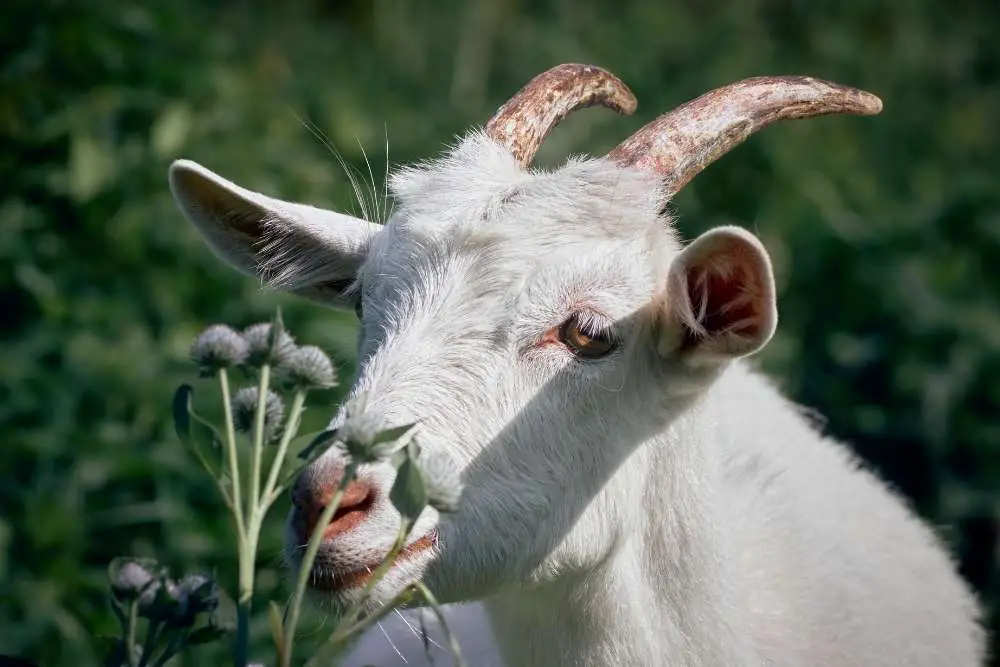If you have ever known someone who has a goat, you know that goats are curious animals. They like to get into things and investigate everything they encounter. This makes goats prone to injury, It is not uncommon for goats to lose their horns, but a common question is, do goats’ horns regrow?
The short answer is yes. Goat horns can grow back if they are cut or broken off. However, if they are correctly dehorned, they will not grow back.
If a goat loses its horns in an accident, there is a chance it will grow back in time. As the goat grows older, some of their horn mass will fill in naturally with hormones, which causes the missing horn to start growing again from thicker skin and cartilage at the base of their skull.
This result is a common misconception. Horns are made of keratin, which is the same material found in hair. The horn “growth” does not grow back into the skull but instead grows into the skull’s skin at the base of their horns. The skin on their skull will then flatten and raise slightly around the horn base, creating a somewhat bulbous appearance on the side of the head where it meets with their cheekbone. This is caused by swelling due to hormone changes and is not permanent.
What Do Goats Use Their Horns For?
Goats use their horns for defense, dominance displays, to defend their territory, and as a means of communication. They often use these senses to help find food. If they hear a rustle, they will investigate the area with their horns lowered or raised and may even be looking for food at that time.
Can Goat Horns Fall Off?
Unlike deer, goats do not lose their horns.
A goat’s horn is excellent for protection against other predators and does not need to be replaced like a deer’s antler or tusk!
However, goat horns can be broken off. Goat horns can be broken in two different ways: by direct force or by a blunt object. The fracture type depends on how the horns were broken. If a goat’s horns were fractured, they would grow back to resemble the original horn shape but may not be identical. This is because they are essentially designed to redirect an injury’s energy and allow the goat to continue to use that part of its body.
If a goat’s horns were broken by force, the injury site would heal over quickly. The horn then will be as it was before the break, but it will be shorter or shorter in a different location than the original horn. They cannot be disbudded.
Why Do Goats Have Horns?
A goat’s horns perform many duties, but one lesser-known function is to act as an air conditioning system during hot weather. However, the first purpose and most well-known are for protection if the animal’s territory or food sources become threatened by predators.
Because goat horns are used to regulate their body temperature, you should never dehorn an angora goat.
How Do You Dehorn A Goat?
There are two types of dehorning. The first is chemical dehorning; the second is surgical dehorning, which is more common. In the first type, the horns are removed using a chemical solution that burns off the keratin responsible for growth without harming or otherwise affecting the goat. This method is effective, but it’s also painful to the animal, and there are some risks involved, including side effects such as infection and scarring.
The second method, surgical dehorning, involves removing horns using a combination of a scalpel and anesthesia. This is the preferred procedure if you plan on keeping your goat as an adult. The whole process takes around 10 to 15 minutes and leaves no visible scarring in most cases. The downside to this method is that it can be pretty costly, and there are risks of infection or other complications related to the use of anesthesia.
What Happens if a Goat’s Horn Breaks Off?
If goat horns are broken off or damaged in some way, they will grow back. However, they will never look like they did before they were broken.
Goat horns are connected to the skull by bone and blood vessels. These connections can cause pain if not maintained properly and can lead to infection or other complications if left untreated. Dehorning a goat is usually the best option for keeping horns healthy because it leaves their head free from injury and better able to handle rough weather when they live in harsher climates.
What to Do For a Goat With a Broken Horn?
A goat’s horn is not likely to break. However, if goats are fighting or playing aggressively with their horns, they can get stuck on something and snap off! If a goat’s horn breaks, what will happen?
The first thing you need to do is make sure the goat is in a safe place. Goats’ horns typically have blood vessels, so it is entirely possible for them to bleed profusely. If they are bleeding badly, then you will need to stop them from bleeding. Call your local veterinarian or call for help from your local certified goat veterinarian.
If they are not bleeding, then make sure there are no other injuries. Check the head, legs, and belly for bruises and cuts. Check the goat’s mouth and nose and take note if they are drooling any blood from their mouth or nose.
Horns are important to goats, but if they were not properly removed and break, it could lead to many problems. There’s also a chance that the goat can go into shock and potentially lead to sickness or lack of appetite. If it seems like the site is getting infected, consider giving them antibiotics or taking them to your vet for treatment.
Are Goat Horns Dangerous?
Goat horns are not dangerous to people in general. However, this can change if you have a goat with aggressive behavior and more likely to be the aggressor in an interaction. If a goat becomes more aggressive because of its treatment, its horns can escalate the danger for any person who comes into contact with them.
This doesn’t apply to goats with scurs because they are attached to the skin. Scurs can bleed when removed or broken, but it isn’t nearly as severe as fully-grown horns breaking.
What are Scurs?
Goat scurs are usually natural growths on the head that resemble horns. They are a relic of the goat’s actual horns and can grow back if they are broken. They are sometimes removed for cosmetic purposes or to reduce the risk of injury during fights with other goats or other animals.
Scurs usually have a single point, but they can be shaped into a screw shape or left long and pointed. They occur when a goat hasn’t been appropriately dehorned.
How Fast Do Goat Horns Grow?
When a kid is born, their horns are just buds that will start to grow once they’re one month old. If not removed by disbudding before the kids turn 1-month-olds, goat’s horns can continue growing throughout their life until 8 inches long and 12 inches in length. The rate may vary depending on the quality of nutrition, disease states, and other factors.
Do the horns grow back after they have been removed?
No. If a goat has fully developed horns, it will not grow back if they are successfully removed at an early age. However, they can grow back if a goat isn’t completely dehorned. This can be particularly damaging if the sick or injured goat isn’t adequately cared for.
What are the Different Types of Horns?
Goat horns are also classified as short and long:
Short Goat Horns: Shorthorns go from the skull base to the tips and can be found in most dairy goats. They are short near the head but usually grow longer and more curved toward the butt. Curved short horns are typical in goats explicitly bred for milk production or meat. Shorthorns can be disbudded when they are about 3 weeks old, which means they push out quickly.
Long Goat Horns: Long goat horns grow off their skulls and wrap back around them a few inches from their necks’ base. They are usually long and straight and may not curve. Longhorns are not common in dairy goats, but they do occur in some meat goats.
Size: Dairy goats usually have longer horns than meat goats. The average horn length for dairy goats is 6-8 inches. Meat goats usually have horns that measure 4-6 inches. A goat’s gender is also determined by horn length: males have longer horns, females are short or medium, and sometimes long.
What Are Goat Horns Made Out Of?
A goat’s horns are made of keratin, just like your fingernails. Every time a goat’s horn grows, it is due to new keratin being formed from the skull’s skin at the base of their horns which then pushes its way out.
Do Goats Feel Pain in Their Horns?
Goats can feel pain in their horns, but not the way you think. The horns of a goat are rugged and robust, but they’re still sensitive. The horn is composed mainly of blood vessels or nerves inside with hair-like structures on the outside that look relatively insensitive. But don’t be fooled! They might have an exterior coating that appears to resist damage by accident or otherwise, but what’s important is what lies beneath it – the root area which houses dense nerve matter just as delicate as skin directly under fingernails.
Conclusion
A goat’s horns grow back if they were broken off but will never look the same. If you dehorned them properly, then their horns won’t grow back and won’t need to worry about it growing back as scurs.
Goats also use their horns for protection, dominance displays, to defend their territory, and as a means of communication. If they hear a rustle, goats will investigate or playfully fight with another goat with their horns lowered or raised depending on the situation.

